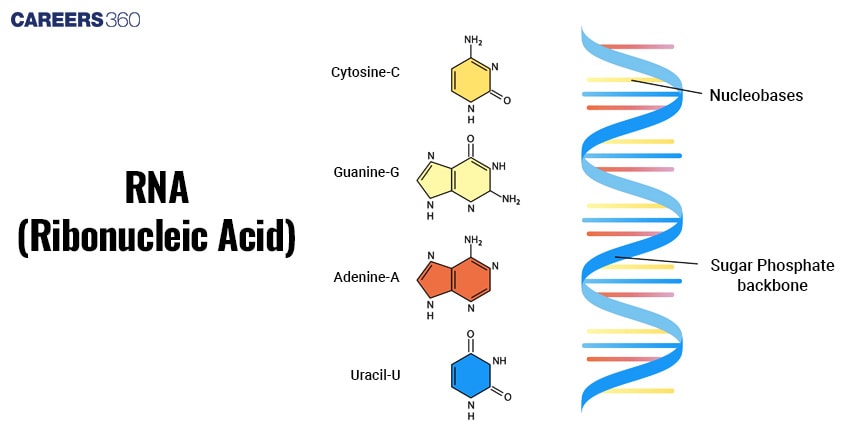Structure of RNA: Know Functions and Types
The structure of RNA (Ribonucleic Acid) is an important concept in biology. RNA, unlike DNA, is usually single-stranded and helps transfer and use genetic information in cells. It plays an important role in protein synthesis and gene regulation. This topic is part of the Class 12 chapter Molecular Basis of Inheritance in Biology. Questions from this are often asked in exams like NEET and AIIMS BSc Nursing. Knowing RNA’s structure and functions is helpful for understanding cell processes and gene expression.
NEET 2025: Mock Test Series | Syllabus | High Scoring Topics | PYQs
NEET Important PYQ's Subject wise: Physics | Chemistry | Biology
New: Meet Careers360 B.Tech/NEET Experts in your City | Book your Seat now
- What is RNA?
- Basic Structure of RNA
- Levels of RNA Structure
- Types of RNA
- Function of RNA
- Recommended Video on Structure of RNA

What is RNA?
RNA is possibly one of the most important biological molecules. It is responsible for some of the major functions like coding, decoding, regulation, and expression of genes. Being double-stranded, DNA gets support from the double strands and hence acts only as a repository of genetic information. Most of the RNA is single-stranded and directly participates in protein synthesis and other cellular activities. It was discovered at the turn of the 20th century, although the influential years in understanding its structure and functions were the subsequent ones.
It is one of the central elements of the central dogma of molecular biology, outlining the flow of genetic information from DNA to RNA and finally into proteins in a biological system. Contrary to its working as a messenger, carrying the instructions from DNA to regulate protein synthesis, it has several other forms and functions that influence structural, catalytic, and regulatory activities.
Also Read:
Basic Structure of RNA
RNA is synthesised from simpler constituents that configure its unique structure and support its several functions. Ribonucleic acid is included in the class of nucleic acids that carry genetic information.
Nucleotides
Nucleotides are monomeric constituents of RNA. A nucleotide is made up of a sugar molecule known as ribose, a phosphate group, and one nitrogenous base. Unlike the deoxyribose sugar of DNA, the ribose sugar of RNA contains an additional hydroxyl group. This makes a difference in stability and makes RNA different in function. This is one of the critical differences between RNA and DNA.
Nitrogenous Bases
There are four types of nitrogenous bases in RNA: Adenine A, Guanine G, Cytosine C, and Uracil U. These are held by hydrogen bonds forming definite base pairs wherein Adenine is pairing with Uracil A-U and Guanine pairing with Cytosine G-C. This base pairing is important for secondary structure and function in RNA.
Phosphodiester Bonds
The phosphodiester linkage refers to the sugar-phosphate backbone that holds the nucleotides together in RNA. Besides, these join the 5' phosphate group of one nucleotide to the 3' hydroxyl group of the succeeding nucleotide, thus forming a continuous chain with direction from the 5' to the 3' end. This is very important in such processes as transcription and translation.
Levels of RNA Structure
After that, several ranges of RNA structures lend their way to its function and stability.
Primary Structure
The primary structure of RNA is regarded as a linear sequence of nucleotides within RNA, which determines the properties and role of RNA. Specific coding of the proteins would be therein, but also several regulatory elements. Indeed, arranging such nucleotides is very crucial for the accurate transfer of genetic information.
Secondary Structure
The RNA secondary structure is the interaction between complementary bases by hydrogen bonding, leading to the formation of common motifs such as stem loops. All these structures have a very important function in preventing degradation and favouring the stability of the RNA during its functions, allowing it to form compact shapes that will interact with other molecules.
RNA Structure Diagram
Given below is the diagram of an RNA structure with its parts

Tertiary Structure
The tertiary structure refers to the three-dimensional folding of RNA, driven by many interactions between the secondary structural elements. The cloverleaf structure of tRNA and the complicated folding of rRNA inside the ribosome are examples of such. These complex shapes empower RNA to carry out its sundry activities within the cell.
Types of RNA
Types of RNA and their functions are explained below:
tRNA (Transfer RNA)
It carries amino acids to the ribosome, followed by their incorporation into the protein under construction. tRNA contains regions that base-pair with the mRNA codon, properly aligning amino acids in the growing protein.
rRNA (Ribosomal RNA)
Ribosomal RNA provides a structural core to the ribosome, docking the substrate. rRNA acts as a scaffold and a catalyst in communicating with mRNA and tRNA to translate genetic information into the amino acid sequences of products correctly.
mRNA (Messenger RNA)
It is a messenger RNA that bears genetic information from DNA to the ribosome, which then acts as a template for the construction process of proteins. It refines through certain events like capping, polyadenylation, and splicing processes until the mature mRNA is translated into the processing of proteins.
Function of RNA
It is in many pivotal roles within the cell that RNA molecules fulfil their duty, and each type of RNA makes its uniquely essential contribution to the process of gene expression and regulation.
mRNA Function
Transcription is the process through which the messages in part of the DNA molecule are transcribed into RNA—messenger RNA. The mRNA undergoes processing, which includes the addition of the cap at the 5′ ends and the formation of the poly-A tail at the 3′ ends, besides splicing to remove the introns. That is, processed mature mRNA mediates the transfer of the genetic code across to the ribosome for translation into a protein.
tRNA Function
The role of tRNA is to carry the message in the mRNA code and translate it into protein. Each tRNA molecule holds an anticodon that shall recognize a particular codon expressed in the mRNA strand, plus a bound amino acid. In translation, tRNAs bring the appropriate amino acids to the ribosome to incorporate into the growing polypeptide chain.
rRNA Function
Ribosomal RNAs are major constituents of the ribosomes, which are cellular machines for protein synthesis. It ensures the correct alignment of mRNA and tRNAs and catalyses the joining of amino acids through peptide bonds. Proper and efficient generation of proteins depends on rRNA.
Other Non-Coding RNAs
Apart from mRNAs, rRNAs, and tRNAs, a large number of RNAs are non-coding but involved in myriad regulatory functions. MicroRNAs and small interfering RNAs, for example, are involved in modulation by expression of genes due to RNA interference. RNA molecules of this kind have been described to exert negative modulation on mRNA stability and translation for target genes, controlling some cellular events.
Also Read:
Recommended Video on Structure of RNA
Frequently Asked Questions (FAQs)
The types of RNA exist that are called mRNA, tRNA, and rRNA. mRNA, which carries genetic information from DNA out to the ribosomes for protein synthesis; tRNA, which carries amino acids to the ribosome during protein synthesis; and rRNA, which makes the core of the ribosome and facilitates protein synthesis.
Generally, RNA is single-stranded, left-handed, and contains uracil instead of thymine and ribose sugar. However, DNA is double-stranded with deoxyribose and uses thymine.
mRNA is a single-stranded molecule including a 5' cap with a coding region and a 3' poly-A tail. These both are important for stability and translation into protein.
Participation of RNA in protein synthesis occurs in three ways: it carries the genetic information, mRNA; brings the right amino acids; and forms the core of the ribosome, the place for protein synthesis.
In aspects of biotechnology, RNA has its uses running from RNAi in gene silencing to editing genes via the CRISPR method, and the mRNA vaccines against diseases like COVID-19.
The full form of RNA is Ribonucleic Acid.
Also Read
29 Nov'24 09:31 AM
19 Nov'24 09:26 AM
18 Nov'24 06:45 PM
18 Nov'24 09:29 AM
18 Nov'24 09:18 AM
18 Nov'24 09:01 AM
18 Nov'24 08:37 AM
16 Nov'24 03:45 PM